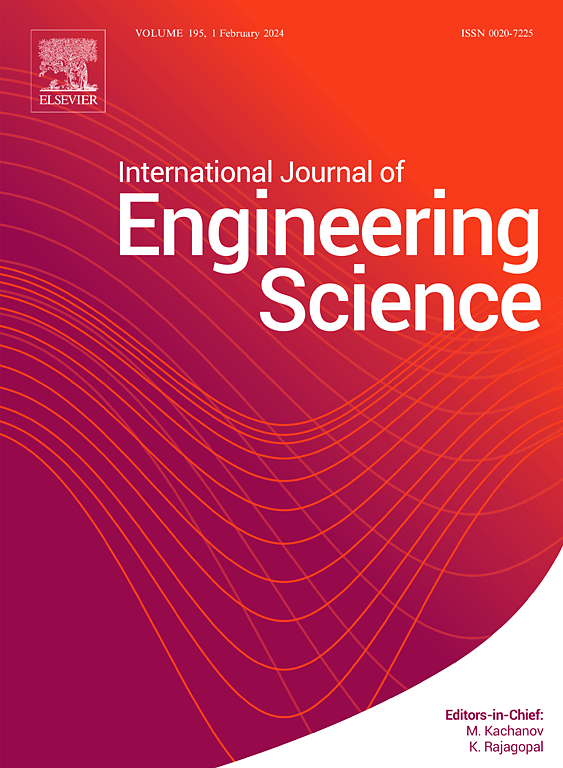包含非局部和表面效应的多孔机械超材料结构的构型多尺度方法
IF 5.7
1区 工程技术
Q1 ENGINEERING, MULTIDISCIPLINARY
International Journal of Engineering Science
Pub Date : 2025-07-25
DOI:10.1016/j.ijengsci.2025.104354
引用次数: 0
摘要
超材料表现出违反直觉的力学行为,这些行为来自于它们的人工介观结构构型,而不是每个单独组分的力学性能。然而,经典的多尺度均匀化方法无法捕捉到反直觉的力学行为。本文探讨了介观结构对多孔力学超材料结构的反直觉力学行为的作用,并将观察到的效应归因于由介观结构引起的非局部和表面效应。为了有效、准确地预测多孔力学超材料结构的非局部和表面效应,提出了一种包含非局部和表面效应的构型多尺度方法。在中尺度上,构造了变厚度代表体积元(RVE);在变厚度RVE的基础上,针对不同的配置,标定了非局部效应和表面效应的本征长度参数,从而构建了离线数据集。在宏观尺度上,将多孔力学超材料结构建模为包含非局部和表面效应的均质结构,推导了多孔力学超材料杆的位移闭合解。借助固有长度参数的离线数据集和位移的封闭形式解,将所提出的构型支持多尺度方法的性能在精度和计算效率方面进行了评估,并直接与完全解决细观结构构型的高保真有限元方法(FEM)进行了比较。结果表明,结合非局部和表面效应的构型多尺度方法不仅能准确表征多尺度结构,显著优于经典的多尺度均匀化方法,而且能显著降低高保真有限元的计算效率。本文章由计算机程序翻译,如有差异,请以英文原文为准。
A configuration-enabled multiscale method for porous mechanical metamaterial structures incorporating nonlocal and surface effects
Metamaterials exhibit counterintuitive mechanical behaviors that derive from their artificial mesostructural configuration rather than the mechanical properties of each individual component. However, classical multiscale homogenization methods cannot capture the counterintuitive mechanical behaviors. This paper explores the role of mesoscopic configurations on the counterintuitive mechanical behavior of porous mechanical metamaterial structures, attributing the observed effects to nonlocal and surface effects arising from the configurations. A configuration-enabled multiscale method incorporating nonlocal and surface effects is proposed for porous mechanical metamaterial structures to efficiently and accurately forecast the configuration-induced nonlocal and surface effects. In the mesoscale, a variable-thickness representative volume element (RVE) is constructed; based on the variable-thickness RVE, the intrinsic length parameters of nonlocal and surface effects are calibrated for different configurations, thereby constructing an offline dataset. In the macroscale, porous mechanical metamaterial structures are modeled as homogenization structures incorporating nonlocal and surface effects, and the closed-form solution of displacements is derived for porous mechanical metamaterial bars. With the help of the offline dataset of the intrinsic length parameters and the closed-form solution of displacements, the performance of the proposed configuration-enabled multiscale approach, evaluated in terms of accuracy and computational efficiency, is directly compared to a high-fidelity finite element method (FEM) that fully solves the mesoscopic structural configuration. Results indicate that the configuration-enabled multiscale method incorporating nonlocal and surface effects not only offers an accurate representation of the multiscale architecture, significantly outperforming the classical multiscale homogenization approach, but also significantly reduces the computational efficiency of the high-fidelity FEM.
求助全文
通过发布文献求助,成功后即可免费获取论文全文。
去求助
来源期刊

International Journal of Engineering Science
工程技术-工程:综合
CiteScore
11.80
自引率
16.70%
发文量
86
审稿时长
45 days
期刊介绍:
The International Journal of Engineering Science is not limited to a specific aspect of science and engineering but is instead devoted to a wide range of subfields in the engineering sciences. While it encourages a broad spectrum of contribution in the engineering sciences, its core interest lies in issues concerning material modeling and response. Articles of interdisciplinary nature are particularly welcome.
The primary goal of the new editors is to maintain high quality of publications. There will be a commitment to expediting the time taken for the publication of the papers. The articles that are sent for reviews will have names of the authors deleted with a view towards enhancing the objectivity and fairness of the review process.
Articles that are devoted to the purely mathematical aspects without a discussion of the physical implications of the results or the consideration of specific examples are discouraged. Articles concerning material science should not be limited merely to a description and recording of observations but should contain theoretical or quantitative discussion of the results.
 求助内容:
求助内容: 应助结果提醒方式:
应助结果提醒方式:


